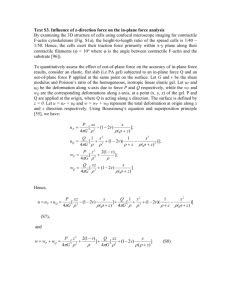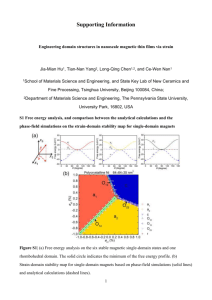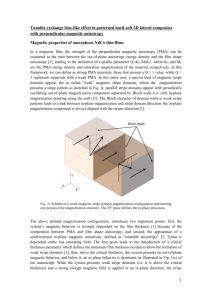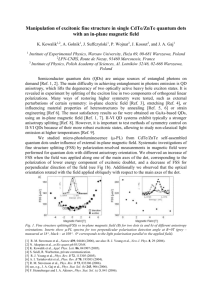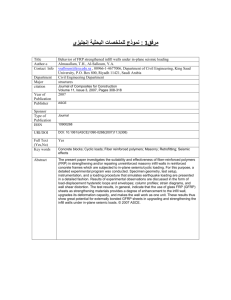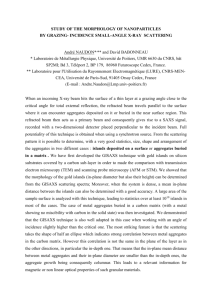Spontaneous domain nucleation under in-plane fields in
advertisement
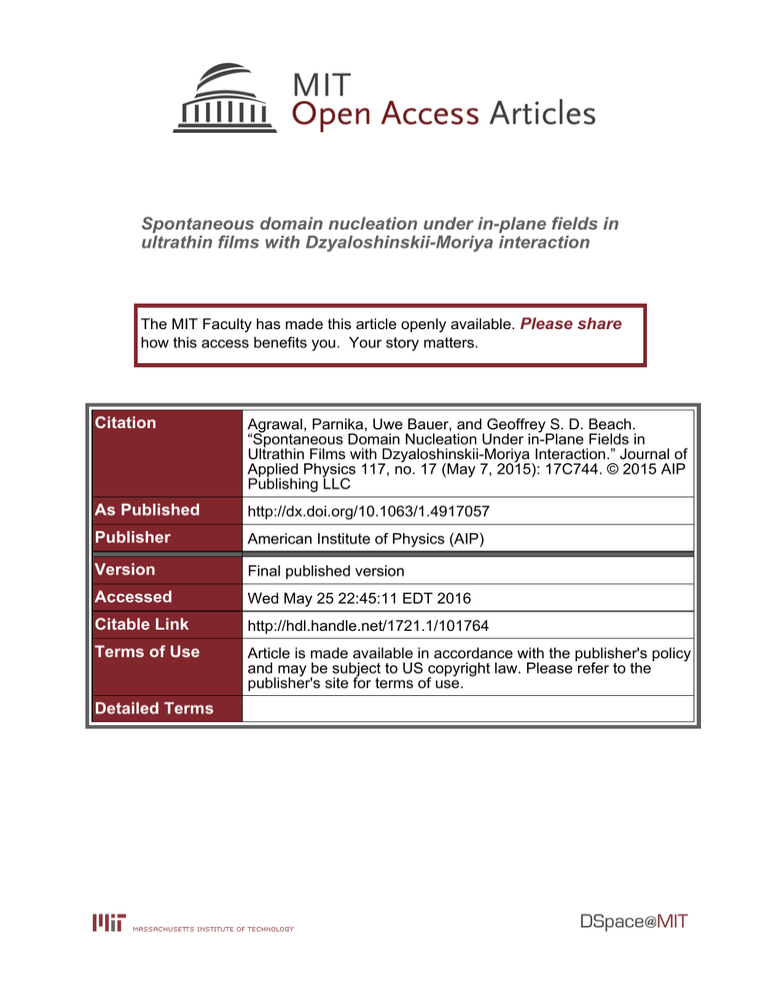
Spontaneous domain nucleation under in-plane fields in ultrathin films with Dzyaloshinskii-Moriya interaction The MIT Faculty has made this article openly available. Please share how this access benefits you. Your story matters. Citation Agrawal, Parnika, Uwe Bauer, and Geoffrey S. D. Beach. “Spontaneous Domain Nucleation Under in-Plane Fields in Ultrathin Films with Dzyaloshinskii-Moriya Interaction.” Journal of Applied Physics 117, no. 17 (May 7, 2015): 17C744. © 2015 AIP Publishing LLC As Published http://dx.doi.org/10.1063/1.4917057 Publisher American Institute of Physics (AIP) Version Final published version Accessed Wed May 25 22:45:11 EDT 2016 Citable Link http://hdl.handle.net/1721.1/101764 Terms of Use Article is made available in accordance with the publisher's policy and may be subject to US copyright law. Please refer to the publisher's site for terms of use. Detailed Terms Spontaneous domain nucleation under in-plane fields in ultrathin films with Dzyaloshinskii-Moriya interaction Parnika Agrawal, Uwe Bauer, and Geoffrey S. D. Beach Citation: Journal of Applied Physics 117, 17C744 (2015); doi: 10.1063/1.4917057 View online: http://dx.doi.org/10.1063/1.4917057 View Table of Contents: http://scitation.aip.org/content/aip/journal/jap/117/17?ver=pdfcov Published by the AIP Publishing Articles you may be interested in The role of weak interlayer coupling in the spin-reorientation of perpendicular ultrathin Co-Fe-B/MgO-based heterostructures Appl. Phys. Lett. 106, 132408 (2015); 10.1063/1.4915323 Asymmetric spin-wave dispersion due to Dzyaloshinskii-Moriya interaction in an ultrathin Pt/CoFeB film Appl. Phys. Lett. 106, 052403 (2015); 10.1063/1.4907173 Two-dimensional control of field-driven magnetic bubble movement using Dzyaloshinskii–Moriya interactions Appl. Phys. Lett. 106, 022402 (2015); 10.1063/1.4905600 Current-driven dynamics of Dzyaloshinskii domain walls in the presence of in-plane fields: Full micromagnetic and one-dimensional analysis J. Appl. Phys. 115, 213909 (2014); 10.1063/1.4881778 Chiral magnetization textures stabilized by the Dzyaloshinskii-Moriya interaction during spin-orbit torque switching Appl. Phys. Lett. 104, 092403 (2014); 10.1063/1.4867199 [This article is copyrighted as indicated in the article. Reuse of AIP content is subject to the terms at: http://scitation.aip.org/termsconditions. Downloaded to ] IP: 18.189.113.74 On: Fri, 10 Apr 2015 21:54:16 JOURNAL OF APPLIED PHYSICS 117, 17C744 (2015) Spontaneous domain nucleation under in-plane fields in ultrathin films with Dzyaloshinskii-Moriya interaction Parnika Agrawal, Uwe Bauer, and Geoffrey S. D. Beacha) Department of Materials Science and Engineering, Massachusetts Institute of Technology, Cambridge, Massachusetts 02139, USA (Presented 5 November 2014; received 22 September 2014; accepted 23 November 2014; published online 10 April 2015) In this paper, we show that applying a hard axis field reduces the energy barrier for the spontaneous formation of a multi-domain state in magnetic ultrathin films sandwiched between a heavy metal and an oxide. This provides a simple technique to generate a metastable multi-domain state in magnetic films where the ground state is uniform. This approach could be particularly interesting in materials with strong Dzyaloshinskii-Moriya interaction as a means to realize metastable C 2015 AIP Publishing LLC. [http://dx.doi.org/10.1063/1.4917057] chiral textures. V Out of plane magnetized thin films which are sandwiched between an appropriate heavy metal and an oxide can exhibit chiral spin textures such as Neel domain walls and skyrmions. This is because of the DzyaloshinskiiMoriya Interaction (DMI) that comes from broken inversion symmetry and a strong spin orbit coupling in these systems.1–5 In these sandwich structures, the heavy metal underlayer contributes to the strong spin orbit coupling.6–9 The inversion symmetry is broken because the magnetic layer has different under-layer and over-layer. If DMI is strong enough, the system will spontaneously exhibit stable chiral spin structures.2 However, in this paper, we show that in the ultrathin sandwich structures of Pt/CoFe/MgO, where the stable state is a uniform magnetic domain, we can induce a metastable multi-domain state by the application of in-plane magnetic field parallel to the film plane, which is higher than a critical threshold but less than the uniaxial anisotropy field. Recently, it has been shown that micromagnetic simulations predict, and spin Hall switching experiments confirm, the creation of chiral intermediate states in Pt/CoFe bilayer strips with a combination of field application and pulsed current injection parallel to each other and the film plane.10 However, this could only be achieved with a limited combination of current and field values along the switching phase boundary. Moreover, this process of creation of intermediate states involved additional complexity due to the need for simultaneous application of current pulses and in-plane field. Here, we describe a process where only in-plane fields are applied to create the metastable multi-domain state. Thin films with Ta(3 nm)/Pt(3 nm)/Co80Fe20(0.6 nm)/ MgO(1.8 nm)/Ta(2 nm) were prepared by DC magnetron sputtering under 3 mTorr Ar with a background pressure of 1 107 Torr, on thermally oxidized Si(100) substrates at room temperature. MgO was RF sputtered at 3 mTorr Ar. Vibrating sample magnetometry measurements of these samples confirmed the presence of perpendicular anisotropy in these films with an in-plane anisotropy field HK 5000 Oe.1 a) Author to whom correspondence should be addressed. Electronic mail: gbeach@mit.edu. 0021-8979/2015/117(17)/17C744/4/$30.00 The magnetization was probed by using Polar MagnetoOptic Kerr Effect (MOKE) with a 532 nm diode laser focused on a 3 lm spot and attenuated to 1 mW. These films have a strong DMI with a DMI-effective field HD 2200 Oe.11 Thus, the ratio of the DMI-effective field to the in-plane anisotropy field in these films is 0.44, which is about 70% of the critical ratio required for spontaneous formation of chiral spin textures. Fig. 1 shows a series of hysteresis loops measured by using the MOKE in the presence of different in-plane (parallel to the film plane) fields Hx. In the absence of any in-plane field, the hysteresis loop is square with a coercivity (Hc) of 40 Oe, which is characteristic of the single domain magnetic state pointing out of the film-plane expected in these thin films. Hc in this case corresponds to the nucleation field of reverse domains, since the domain wall propagation field in these samples is <20 Oe.1 As the magnitude of in-plane field is increased, we find that the coercivity decreases with inplane field, showing that it becomes easier to nucleate reverse domains when an external in-plane field is present. The hysteresis loops start becoming more and more sheared and the remnant magnetization MR at zero out-of-plane field Hz also starts decreasing after a critical threshold of in-plane field is crossed (see Figs. 1(d)–1(f)). Note that these in-plane fields are lower than the anisotropy field for these films which is around 5000 Oe.11 An MR/MS ratio of <1 in the presence of in-plane fields lower than the anisotropy field is indicative of a multi-domain state with stripe domain pattern.10,12 This stripe domain pattern is expected whenever the demagnetization field exceeds the threshold for nucleation of reverse domains. To probe the formation of the stripe domain state, in detail, we measure the out-of-plane component of magnetization Mz as a function of applied in-plane field Hx. Mz was measured by using polar MOKE system described above. Fig. 2(a) shows a schematic for this measurement. An in-plane field Hx serves to ~ of the film such that the out-of-plane cant the magnetization M component of the magnetic moment vector Mz ¼ MS sin(u), where u is the canting angle. According to the StonerWohlfarth model, cos(u) ¼ Hx/HK for Hx < HK. So 117, 17C744-1 C 2015 AIP Publishing LLC V [This article is copyrighted as indicated in the article. Reuse of AIP content is subject to the terms at: http://scitation.aip.org/termsconditions. Downloaded to ] IP: 18.189.113.74 On: Fri, 10 Apr 2015 21:54:16 17C744-2 Agrawal, Bauer, and Beach J. Appl. Phys. 117, 17C744 (2015) FIG. 1. Easy axis hysteresis loops of Pt/CoFe/MgO measured by using Polar MOKE system at in-plane field Hx of (a) 0 Oe; (b) 2000 Oe; (c) 2500 Oe; (d) 3000 Oe; (e) 4000 Oe, and (f) 5000 Oe. Mr and Hc decrease progressively as in-plane field increases. Mz =MS ¼ sin ðarccos ðH x =H K ÞÞ: (1) We measured Mz vs Hx using a lock-in technique to improve the signal-to-noise ratio. In this measurement scheme, we apply pulses of out-of-plane field Hz, as shown in Fig. 2(b), to toggle the magnetic moment MS above and below the film plane. A lock-in amplifier which is phase locked to the Hz field pulses is then used to extract Mz, as shown in Fig. 2(b). For a uniaxial system, Mz vs Hx should take the form of Eq. (1). Fig. 2(c) shows a plot (blue dots) of the measured magnetization Mz as a function of in-plane field Hx. The red curve is the expected Mz vs Hx plot simulated by using Eq. (1) and using anisotropy field value HK as 5000 Oe from Ref. 11. The measured Mz is significantly lower than the expected curve for in-plane field above 1500 Oe. This suggests spontaneous demagnetization and the formation of multi-domain state above the threshold in-plane field. The hysteresis loops in Figs. 1(a)–1(f) were measured at the corresponding in-plane field values as marked in Fig. 2(c) showing a steady decrease in remanence. We found that this multi-domain state persisted even after the in-plane field was removed. This was confirmed by performing another series of experiments where we applied an in-plane field to induce the formation of the multi-domain state, then turned it off and probed the out-of-plane magnetic moment Mz using the polar MOKE. We then applied an out- of-plane field Hz to find the field required to drive the multidomain state to complete saturation. Fig. 3(a) shows a schematic of this measurement. We see that the Kerr signal (which is proportional to Mz) drops significantly on the application of in-plane field Hx and the demagnetized state is retained until Hz is swept. Fig. 3(b) shows a plot of Mz as a function of Hz measured in the region where Hx is turned off. As seen from the plot, the initial magnetization (Mi in the figure) is close to zero immediately after the application of a high Hx, and gradually increases as out of plane field increases until it reaches saturation magnetization MS. Note that the initial magnetization is not zero because of misalignment of the in-plane field. The small out-of-plane component of the in-plane field biases the magnetic moment either up or down leading to some fractional remanence. Branch 1 of the loop corresponds to the initial magnetization curve of the sample which occurs through domain expansion. The saturation field starting from the demagnetized state is denoted by H* in the figure, and is a measure of the range of out-ofplane field required to drive domain walls. In repeated measurements, we found H* to be systematically somewhat lower than Hc, which is the field required to nucleate a reverse domain (branch 3). We also noticed that branch 1 is typically more spread out than branches 2 and 3. Fig. 3(c) plots the absolute value of the initial magnetization Mi described above as a function of in-plane field Hx. [This article is copyrighted as indicated in the article. Reuse of AIP content is subject to the terms at: http://scitation.aip.org/termsconditions. Downloaded to ] IP: 18.189.113.74 On: Fri, 10 Apr 2015 21:54:16 17C744-3 Agrawal, Bauer, and Beach J. Appl. Phys. 117, 17C744 (2015) FIG. 2. Measurement of remnant magnetization as a function of in-plane field: (a) Schematic representation of canting of total magnetic moment MS of the film by the application of in-plane field Hx. Mz represents the out-ofplane component of the magnetic moment vector. (b) Out-of-plane field Hz waveform used to toggle the net magnetic moment between up and down states. The blue and green curves show the toggling of Mz with Hz at inplane fields of 0 Oe (blue) and 2000 Oe (green). (c) Plot of out-of-plane magnetization Mz as a function of in-plane field, measured by lock-in amplifier (blue curve) and theoretically predicted (red curve) by Stoner-Wohlfarth model. This mimics the data shown in Fig. 2(c) (which were measured by the lock-in technique), showing a sharp drop in Mi beyond an in-plane field of 1500 Oe and hence indicating the spontaneous formation of the multi-domain state beyond this threshold field. We see that application of an in-plane field reduces the energy barrier for the creation of a domain wall. This can be mathematically seen by considering the domain wall energy as a function of in-plane field as given by13 rDW ðHx Þ ¼ ro þ 2KD D pDMS jHx þ HDMI j; (2) where ro is the Bloch-type domain wall energy density, KD is domain wall anisotropy energy density, and D is the FIG. 3. Measurement of initial magnetization after application of in-plane field: (a) Applied out-of-plane field Hz, in-plane field Hx and the measured Kerr signal as a function of time. Kerr signal drops down significantly after the application of in-plane field denoting the formation of multi-domain state. (b) Plot of Kerr signal against out-of-plane field Hz measured after the in-plane field has been turned off to zero. Arrows denote the order of measurement starting from initial magnetization Mi. (c) Initial magnetization as a function of in-plane field Hx. domain wall width. At high in-plane fields, the third term on the right becomes larger and so the domain wall energy becomes negative. Thus, the demagnetizing field dominates the system dynamics and a multi-domain state is preferred. [This article is copyrighted as indicated in the article. Reuse of AIP content is subject to the terms at: http://scitation.aip.org/termsconditions. Downloaded to ] IP: 18.189.113.74 On: Fri, 10 Apr 2015 21:54:16 17C744-4 Agrawal, Bauer, and Beach In summary, we have shown a simple approach for the creation of metastable multi-domain state in Pt/CoFe/MgO thin films, which could be extended to other films with similar layer structure and DMI parameter. Chiral magnetic textures in thin films are of great interest from the point-of view of low-power data storage in magnetic memory devices.14,15 Magnetic thin films with perpendicular magnetic anisotropy, strong spin-orbit coupling, and strong Dzyaloshinskii Moriya Interaction promise to be excellent candidates for the creation and stabilization of these chiral textures. If the DMI effective field is strong enough, these chiral textures are spontaneously stabilized. However, even in systems with weaker DMI, perturbations can be introduced to create metastable non-uniform states and manipulate them.2 We have shown that destabilization of the ferromagnetic state and formation of stripe domain textures can be achieved simply by applying an in-plane field. This approach could be used, for example, to generate skyrmions in confined structures, such as magnetic dots, rather than through current pulses as previously proposed.2,10,16 This work was supported by the National Science Foundation under NSF-CCS-1408172. 1 S. Emori, U. Bauer, S.-M. Ahn, E. Martinez, and G. S. D. Beach, “Current-driven dynamics of chiral ferromagnetic domain walls,” Nat. Mater. 12(7), 611–616 (2013). 2 J. Sampaio, V. Cros, S. Rohart, A. Thiaville, and A. Fert, “Nucleation, stability and current-induced motion of isolated magnetic skyrmions in nanostructures,” Nat. Nanotechnol. 8(11), 839–844 (2013). 3 Jue, V. Cros, and A. Fert, “Dynamics of A. Thiaville, S. Rohart, E. Dzyaloshinskii domain walls in ultrathin magnetic films,” EPL (Europhys. Lett.) 100(5), 57002 (2012). J. Appl. Phys. 117, 17C744 (2015) 4 S. M€ uhlbauer, B. Binz, F. Jonietz, C. Pfleiderer, A. Rosch, A. Neubauer, R. Georgii, and P. B€ oni, “Skyrmion lattice in a chiral magnet,” Science 323(5916), 915–919 (2009). 5 K.-S. Ryu, L. Thomas, S.-H. Yang, and S. Parkin, “Chiral spin torque at magnetic domain walls,” Nat. Nanotechnol. 8(7), 527–533 (2013). 6 I. M. Miron, K. Garello, G. Gaudin, P.-J. Zermatten, M. V. Costache, S. Auffret, S. Bandiera, B. Rodmacq, A. Schuhl, and P. Gambardella, “Perpendicular switching of a single ferromagnetic layer induced by inplane current injection,” Nature 476(7359), 189–193 (2011). 7 S. Heinze, K. von Bergmann, M. Menzel, J. Brede, A. Kubetzka, R. Wiesendanger, G. Bihlmayer, and S. Bl€ ugel, “Spontaneous atomic-scale magnetic skyrmion lattice in two dimensions,” Nat. Phys. 7(9), 713–718 (2011). 8 C.-F. Pai, L. Liu, Y. Li, H. W. Tseng, D. C. Ralph, and R. A. Buhrman, “Spin transfer torque devices utilizing the giant spin Hall effect of tungsten,” Appl. Phys. Lett. 101(12), 122404 (2012). 9 L. Liu, R. A. Buhrman, and D. C. Ralph, “Review and analysis of measurements of the spin hall effect in platinum,” arXiv preprint: arXiv:1111.3702, 2011 (submitted). 10 N. Perez, E. Martinez, L. Torres, S.-H. Woo, S. Emori, and G. S. D. Beach, “Chiral magnetization textures stabilized by the DzyaloshinskiiMoriya interaction during spin-orbit torque switching,” Appl. Phys. Lett. 104(9), 092403 (2014). 11 S. Emori, E. Martinez, U. Bauer, S.-M. Ahn, P. Agrawal, D. C. Bono, and G. S. D. Beach, “Spin Hall torque magnetometry of Dzyaloshinskii domain walls,” Phys. Rev. B 90, 184427 (2014). 12 O. Hellwig, A. Berger, J. B. Kortright, and E. E. Fullerton, “Domain structure and magnetization reversal of antiferromagnetically coupled perpendicular anisotropy films,” J. Magn. Magn. Mater. 319(1–2), 13–55 (2007). 13 S. Je, D. Kim, S. Yoo, B. Min, and S. Choe, “Asymmetric magnetic domain-wall motion by the Dzyaloshinskii-Moriya interaction,” Phys. Rev. B 88, 214401 (2013). 14 A. Fert, V. Cros, and J. Sampaio, “Skyrmions on the track,” Nat. Nanotechnol. 8(3), 152–156 (2013). 15 N. S. Kiselev, A. N. Bogdanov, R. Sch€afer, and U. K. R€ oßler, “Chiral skyrmions in thin magnetic films: New objects for magnetic storage technologies?,” J. Phys. D. Appl. Phys. 44(39), 392001 (2011). 16 A. Rosch, “Skyrmions: Moving with the current,” Nat. Nanotechnol. 8(3), 160–161 (2013). [This article is copyrighted as indicated in the article. Reuse of AIP content is subject to the terms at: http://scitation.aip.org/termsconditions. Downloaded to ] IP: 18.189.113.74 On: Fri, 10 Apr 2015 21:54:16
